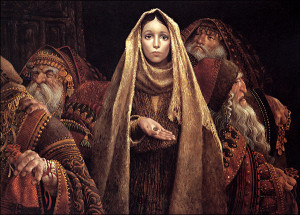Good Friday Sermon: The Only Begotten Daughter
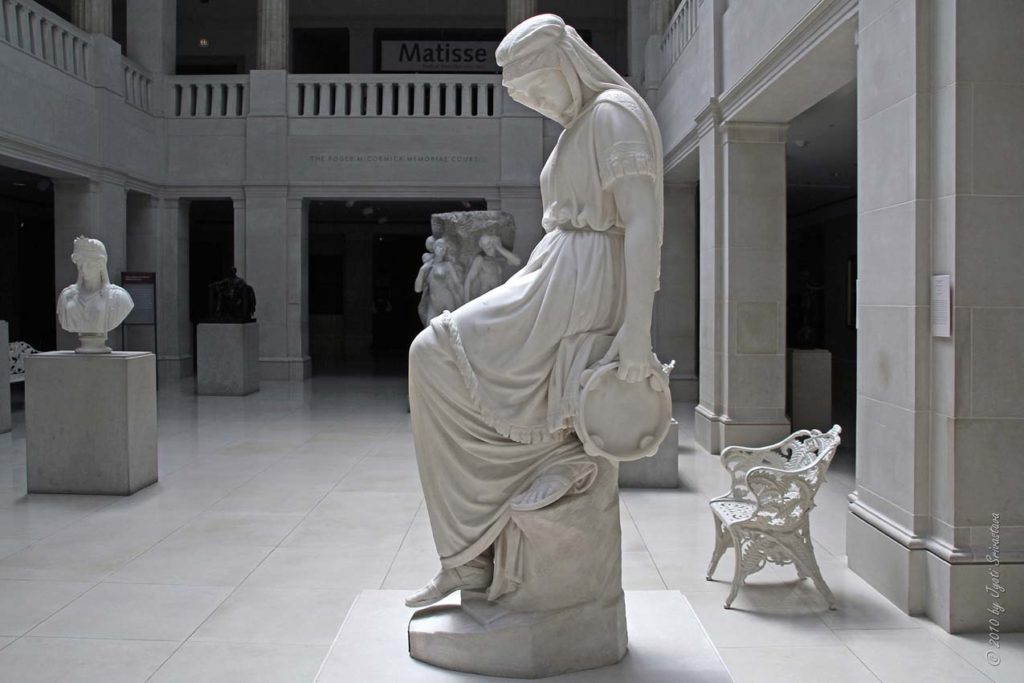
Picture: Jephthah’s Daughter at The Art Institute of Chicago.
Judges 11:29-40; Psalm 22; Hebrews 12:1-4; Luke 22:14–23:56 (Readings from A Woman’s Commentary for the Whole Church, Year A: Good Friday)
“For God so loved the world that God gave God’s only Son…” (John 3:16, Common English Bible [CEB]).
“God said, “Take your son, your only son whom you love…” (Gen. 22:2 CEB)
“Only she, an only child…” (Judges 11:35, A Woman’s Commentary for the Whole Church, Year A: Good Friday. Unless other noted, all Scripture quotations are from A Woman’s Commentary.)
Many of us know about the only sons: Isaac and Jesus. But how many of us know about the only daughter in Judges 11? I suspect not many. The Revised Common Lectionary skips her story. So does The Daily Lectionary in The Book of Common Prayer. Churches that use lectionaries have been trained to skip her story. After all, who wants to hear about a human sacrifice on Sunday morning, the Eucharistic Prayer notwithstanding?
But tonight we hear The Only Daughter’s story. Unfortunately, we cannot call her by name because the men who compiled the book of Judges didn’t think her name was important—just her father’s name is recorded.
The God of Jephthah
The story of The Only Daughter and her father is one straight out of a soap opera or telenovela. Jephthah, the father, is himself an abused son. His mother was a sex worker. His father took him from his mother, and his half-brothers and his stepmother heaped abuse on him. They ran him out of the country, and he became a mercenary. By now the area where he grew up—Gilead—is being attacked by another country, Ammon. Now the people of Gilead want Jephthah and his mercenary army to come and defend them. Jephthah only agrees to do this when the elders say they will make him the head of the region if he drives off the Ammonites. That’s where our reading begins.
For years Jephthah has been a wheeling and dealing manipulator. He knows what to say and what to do to get what he wants. So when the Spirit of the Holy One comes upon him, he does not take it at face value. This is a man who does not take anything at face value—even God. The Spirit of God isn’t enough. So the manipulator begins to wheel and deal because he wants to lead the people who drove him off. This is the deal: If God gives victory to Jephthah, he will offer “the one who comes out—whoever comes out—of the doors of my house to meet me, when I return” to God as a burnt offering.
Who Jephthah thought might be the first out of the door when he returned home after his victory is unclear. The Only Daughter, following the tradition of Miriam and Deborah, greets her father with drums, songs, and dance. And now Jephthah’s foolish and rash vow comes back on him. In his attempt to manipulate God because God’s Spirit was not good enough for him, he stands to lose his only begotten daughter.
Let’s be clear on one point from here on out: Jephthah could have repented of his foolish and rash vow. He could have admitted he was trying to manipulate God with his grandiose vow, humbled himself before God, and admitted his sin of unbelief in the power of God’s Spirit. But he didn’t. Even when the first person to greet him was his daughter-his only child. Instead of admitting his own sin, he blames her telling her, “You have become my trouble.”
The god Jephthah made his vow to will not let Jephthah out of his vow. This petty tyrant is not the Holy One who freely gave her Spirit to Jephthah, to begin with. The god of Jephthah is a rigid and unbending god who cannot forgive a foolish oath. The god Jephthah vowed his vow to makes him keep it—even if keeping it means human sacrifice, which is forbidden by the Torah. Jephthah does not question his own theology, and neither does he bargain with God as Abraham did for Lot’s life. Jephthah’s god does not forgive or relent. What is vowed must be done even if it violates the Torah that was given at Mount Sinai.
The Only Daughter’s response is as troubling as Jephthah’s vow and proclamation: “My father, you have opened your mouth to the Holy One, do to me according to what has gone out of your mouth.” The Only Daughter, not only accepts her fate, she binds Jephthah to his unfaithful words. Both father and daughter trap themselves in a vow that could have and should have been broken and repented of.
But the daughter does set a condition on her obedience: “Release me for two months, and I will go and go down among the hills, and weep for my virginity, I and my women-friends.” The Only Daughter might submit to her manipulative father’s foolish vow, but she will not spend the last months of her life with him: she chooses to spend that time with her women-friends. And those women remember her, and they teach their daughters about her. The daughters remember her, and The Only Daughter becomes “an observance in Israel. Year by year the daughters of Israel would go out to tell the story of the daughter of Jephthah the Gileadite for four days.” The Only Daughter weeps for her virginity, for she will not have children who remember her, but the faithful women in her life make sure she is not forgotten after her death.
In an interview with Christian Century, the author of A Woman’s Lectionary for the Whole Church, Dr. Wilda Gafney, said she intentionally chose each Psalm to be the woman’s or women’s response in the reading from the Hebrew Scriptures. So now we turn to Psalm 22, and hear the Only Daughter cry out: “My God, my God why have you forsaken me?/ Why are you so far from my deliverance, from the words of my groaning?/ My God, I cry by day, and you do not answer;/and by night, and there I find no rest.”
The God of Psalm 22
When we think of these words being cried out, we hear them cried out by Jesus on the Cross. In Dr. Phyllis Trible’s groundbreaking book, Texts of Terror, Dr. Trible applies these words to the daughter: “My God, my God why hast thou forsaken her,” but I have never thought about making these words the Only Daughter’s prayer as she wept and mourned with her friends. Just as God’s only Son felt abandoned on the cross, so Jephthah’s only daughter feels abandoned as well. Jesus prayed in Gethsemane the night before: “Abba, if you are willing, take this cup away from me; yet, not my will but yours be done.” The cup was not taken away for either Only Child.
As we read Psalm 22 the God of the Psalmist is entire universes away from the god of Jephthah: “Yet it was you who drew me from the womb;/keeping me safe on my mother’s breast./On you was I cast from birth,/and since my mother’s womb you have been my God.” The God of Psalm 22 is a nurse and midwife who brings life into the world and helps that life to flourish. This God is loving, caring, and trustworthy, and this is the God Jesus and the Only Daughter call out to in their time of despair.
Who Do We Say God Is?
Dr. Gafney comments that each of these texts requires us to ask who do we think God is. Are we talking about the vengeful tyrant of Judges 11 or the midwife and nurse of Psalm 22? This question matters—because this is the god we bring to tonight’s Passion Reading. Are we looking through Jephthah’s eyes seeing a petty and vengeful god who sends the only Son to be tortured and slaughtered for our sins, so that god’s wrath can be spent on Jesus, just so that same god can forgive us? Or do we bring the loving midwife and nurse of Psalm 22 to our reading of Luke’s Passion? Is God the Holy Midwife who is always bringing new life into this world, and that is the reason God sent the only Son into the world? Jesus died because those in power do not want to hear about the loving God who has no favorites. The powerful do not want the lowly to be raised. And God mourns and weeps with the women at the foot of the cross as Jesus dies just as the Only Daughter’s friends wept and mourned with her. As God weeps, God is preparing to answer this travesty. Yes, those in power—the occupying force of Rome–did the worse they could do to Jesus. But that isn’t the last word. God’s last word will come on Sunday morning.
On this holy night, we believe that Jesus was crucified, died, and was buried. He descended to the dead. Now I’m supposed to stop there, but I’m not. We believe that Jesus descended to the dead—to Sheol—the Hebrew underworld. In many Eastern icons, when Jesus is raised from the dead, he brings Adam, Eve, and all of God’s people from Sheol with him. He brings the Only Daughter with him, and Jesus KNOWS her name. The men who compiled the book of Judges may have forgotten this precious daughter’s name, but God did not.
But it is not Sunday yet. Tonight we mourn. We mourn with the other women in our readings. We mourn with the Only Daughter’s friends, and we mourn with Mary Magdalene, Mary the mother of James and Joseph, Salome, and the other female disciples at the cross. These women do not leave when Jesus is taken off of the cross. After Joseph lays Jesus in the tomb Luke tells us “The women followed, the ones who had come with him from Galilee, and they saw the tomb and how his body was placed.” Matthew tells us: “Mary Magdalene and the other Mary were there, sitting in front of the tomb” holding vigil. Both Jesus and the Only Daughter have cried out: “My God, my God, why have you forsaken me? Why are you so far from my deliverance, from the words of my groaning?” And now there is silence, and we hold vigil.
As we sit in this silence, in this holy and liminal space in the darkness of the tomb, we must remember Jesus Emmanuel: God is with us. God is with us in our lowest and bleakest times. God was with the Only Daughter as she submitted to a father that could not conceive of a God who could forgive a foolish oath. God was with Jesus as his male disciples fled, and the Roman government condemned him to death. Here the promise given at Jesus’ birth is the promise we must hold onto as Jesus lies in the tomb in the silence of Holy Saturday. God is with us. And just as God called the Only Daughter by her name, just as Jesus will call Mary Magdalene by her name, God calls each of us by name as we wait.
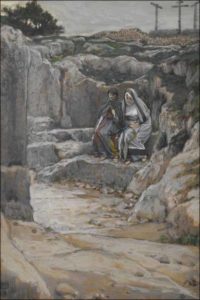
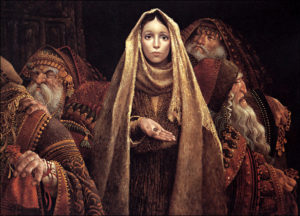
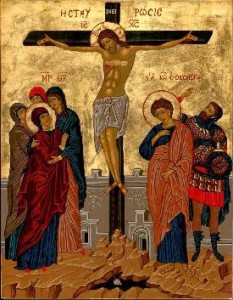 The past few years I have been on a mission to write, preach, and teach the women of Holy Week back into our Holy Week liturgies, practices, and Scriptures. In this post we’ll learn about the women at the cross and tomb in Mark.
The past few years I have been on a mission to write, preach, and teach the women of Holy Week back into our Holy Week liturgies, practices, and Scriptures. In this post we’ll learn about the women at the cross and tomb in Mark.